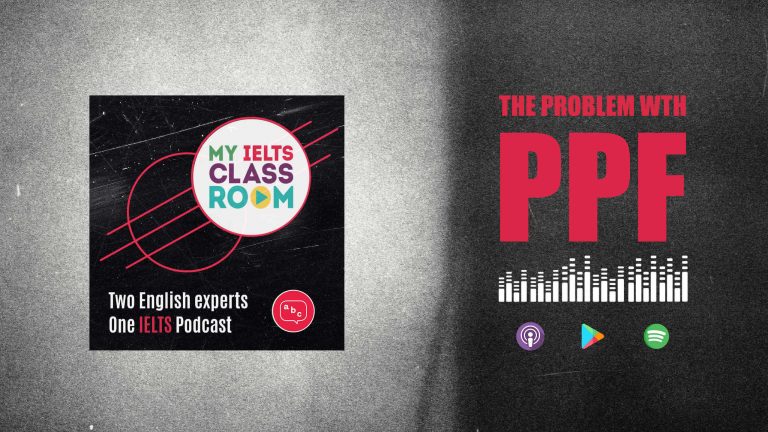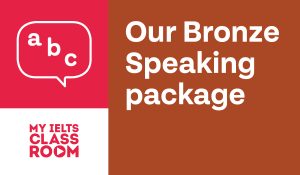
Speaking Part 2: The Problem with the IELTS PPF method!
Speaking Part 2: The IELTS PPF method
There is no doubt that Speaking Part Two can be challenging for many students. After all, talking continuously for 2 minutes is not something we do very often in every day life! However, is using the IELTS PPF method the best way to keep going until the examiner interrupts you?
Nick and I think that it is definitely NOT for three reasons (that sounds like a To What Extent essay!) Listen to today’s episode to find out why we would never recommend this method and to find out our alternative suggestions.
Below, you can find a summary of the episode, which includes all of the links to useful materials and the times of each part of the discussion (so you can go directly to the part you want to listen to) 🚀
Subscribe to My IELTS Classroom podcast on Apple podcasts here
Subscribe to My IELTS Classroom on Google podcasts here
Podcast Summary: Why we don’t like IELTS PPF
00:00 – 05:35 – Introduction: Can you help us choose our logo?
We are re-designing our blog and can’t decide if we should keep our new logo (all orange) or go back to old multi-coloured logo? What do you think?

06:12 – 10:25 – What is the IELTS PPF method?
PPF stands for “Past, Present, and Future”. The idea is that as you talk about the cue card topic, you should give some information about all three times. For example, imagine that you are asked to talk about “Your favourite book”, you may answer like this:
I think that my favourite book is Master and Margarita. I read it a couple of years ago, and although I live in Russia, it is really the only Russian book that I’ve ever finished I like it because the plot is completely different to anything that I have ever read before. Before this, my favourite was Generation X by Douglas Coupland. It describes what life is like as a twenty-something. You know – when you don’t know what job you want or how to fit into adult life. It’s a great book, but I’ve grown out of it now. I guess in the future, I would like to read more of the classics, but I just don’t know if I will have time.
Now, this is way too short for a genuine response, but I hope that you can see that what I did here is talk about my favourite book NOW, then what my favourite book was in the PAST, and then what I hope to read more of in the FUTURE. This is the IELTS PPF method in action.
Sadly, I am not 100% sure who invented the PPF method, so I can’t attribute it to a source, but my guess is that it was a well-meaning teacher who saw that this a good “method” for two reasons:
- it helped their students to keep talking for two minutes
- it helped their students to “show off” their tenses
Sadly, I don’t think that either of these are true! Why? Well, let me explain!
10:26 – 30:34 – Three reasons why the IELTS PPF method is NOT a good idea
1. You cannot use the IELTS PPF method for every card
In fact, I think that you can use it for almost none! If you look at any examiner-pack of cue-card questions, you will see that about 50% ask you to talk about a PAST EVENT. Although it can be natural to move between the past and the present for these cards, I have no idea how you would be able to discuss these topics in the future! Just look at these three current cue card topics. Can you really imagine how you would EASILY discuss these in the future?
- An occasion when you ate something for the first time
- A time when you had to wait in a long line of people/queue
- A time when you encouraged somebody to do something that he/she didn’t want to do
I’m not saying that you couldn’t add some sort of “final comment” but, quite honestly, it would sound very strange to say “and maybe next year I will get to try more new food” or “and in the future, I hope to queue less”!

Remember, the students who do best in the speaking exam are those who answer the questions naturally.
Forcing grammar structures into your answer is NEVER a good idea.
2. Why use the past tense when you don’t have to?
Which brings me to my second point. If you think that using the IELTS PPF method will improve your score for Grammatical Range and Accuracy, you are sadly not correct. Tenses are heavily tested in Part 1 and usually only contribute to negative marking. In other words, I would expect a 7.0+ student to be able to use all of the tenses with ease and would only notice them when they are used incorrectly.
That means that if you want a very high score, using the past, present, and future tenses will do very little to impress the examiner. In Parts Two and Three we are looking for examples of genuinely complex sentences, not tense.

Worse, if you are a low-level student, it is quite likely that you will struggle forming the different tenses accurately,
so why put your self under pressure to produce past, present and future tenses if you don’t need to?
Even high-level students can make errors with the past tenses (particularly with the verbs “have” and “be”) and with nothing to “gain” from using them, why do it?
3. The IELTS PPF method can often lead answers that are not really relevant and sound unnatural
As I said above, examiners are looking for people who find it easy to communicate in English. There are times when moving between times is natural in communicating about the cue card topic. However, robotically giving a past, present, and future “answer” is always noticeable and can lead to you straying from the main topic of your cur card.
Maybe for a 7.0 this isn’t a problem, but if you are aiming for an 8.0 for Fluency and Coherence, we would strongly recommend that you focus more on discussing the main topic on the card. If you run out of things to say and want to mention the past or future, that is absolutely fine. We just don’t recommend that you plan to do this for every card!
What are the alternatives to the IELTS PPF Method?
There are many other simple techniques that you can use to ensure that you are able to keep speaking for two minutes in IELTS Speaking Part Two. We have a number of blog posts that you can refer to for help here. I would recommend:
- The nine types of IELTS cue card. Click here to read
- Never run out of things to say in Speaking Part Two. Click here to read
- The importance of adding details in Speaking Part Two. Click here to read
If you want to listen to Nick and I give feedbacks to students attempting speaking part two, then listen to episode 16: IELTS Cue Card Feedback
30:35 – END – Five current cue card topics that we think are difficult:
To end this week’s episode, Nick and I look at 5 cue card topics that have been reported from the current exam packs which we think are difficult. Why? Listen to find out!
- A time when you had to listen to someone talking about a topic you weren’t very interested in
- A photograph of yourself
- A time when you saw a young child behaving badly in public
- A person’s home you visited that you liked, but would not want to live in
- A person who wears unusual clothes
Would you like expert help to improve your IELTS speaking score?
We offer a 5-day intensive course for IELTS test-takers every month that covers all aspects of speaking, from how to approach each section to how to paraphrase well or address the most difficult questions in Part 3. Even better, with every course being run by an ex-examiner, you will be getting feedback is guaranteed to help you to improve your score. You can read more about the course here.

